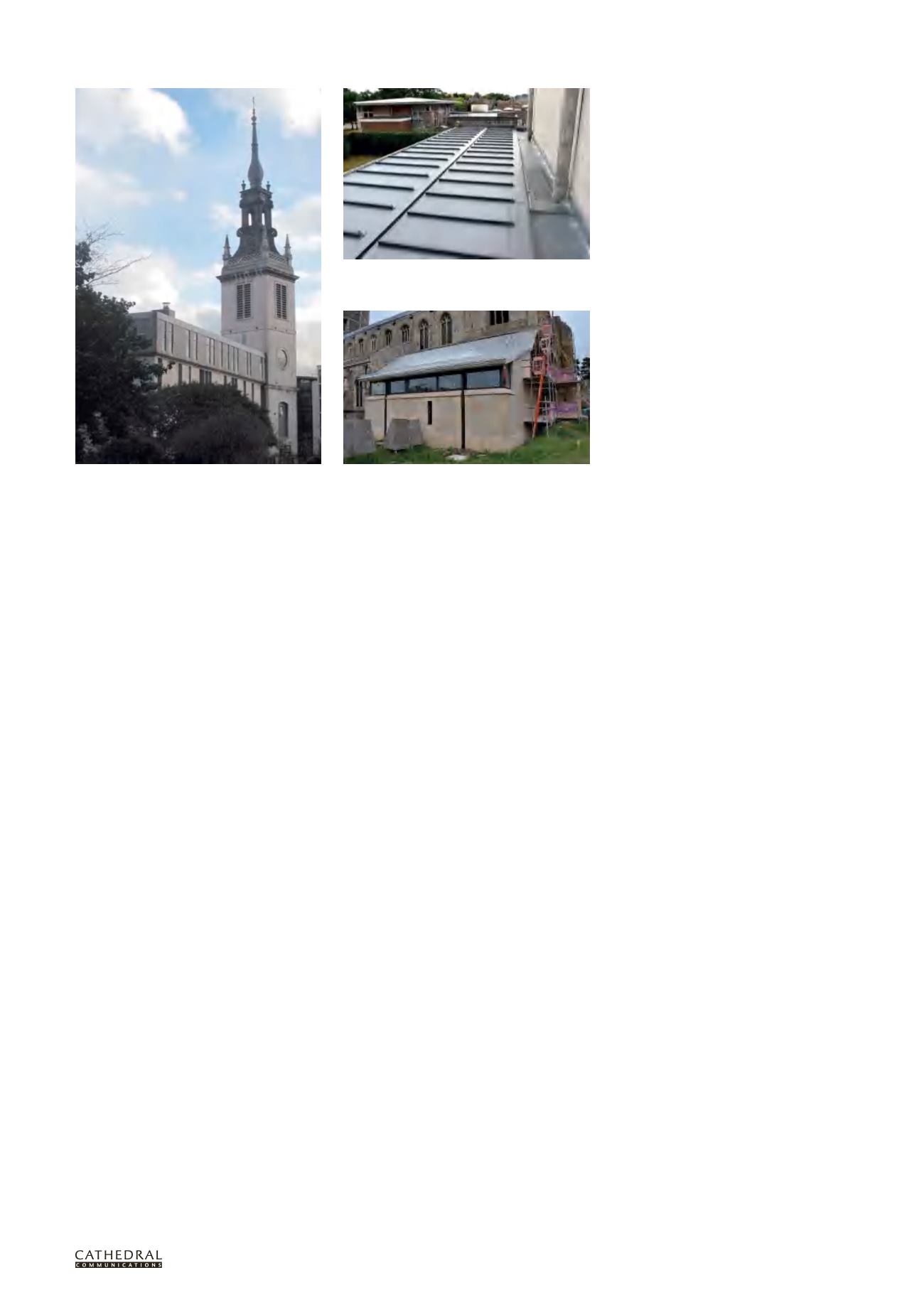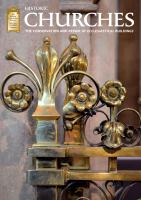

BCD SPECIAL REPORT ON
HISTORIC CHURCHES
22
ND ANNUAL EDITION
31
30 years depending on the quality of
the solar finish applied. However, they
need to be bedded with bitumen which
makes them both problematic to lay
over a historic building structure and
relatively unsustainable as a long term
solution. Their ‘cost in use’ over the life of
a building is relatively high compared to
metal roofing due to the short life-span
before the felt succumbs to embrittlement
due to sunlight (UV radiation).
Fibreglass
Glass fibre was developed by the
American Corning company in the
1930s after a technician accidentally
blew compressed air through a vat
of molten glass. DuPont developed
the resins needed to strengthen the
material and further development in
the 1960s produced glass reinforced
plastic or GRP, which is now widely
used in a range of applications.
Its great selling point is its versatility
and ability to mimic aesthetically any other
material including lead roofing, tiling
and even thatch, and it has often been
used to replicate difficult or inaccessible
roofing details. However, while the glass
content itself is probably indestructible,
the polymer matrix is vulnerable to
embrittlement, fading and scorching
by sunlight, affecting early examples.
Despite recent improvements, its long-
term weathering remains uncertain.
As a rigid, lightweight material,
GRP is also vulnerable to wind-lift, and
although the material is impervious to
moisture, its ability to prevent water
penetration is only as good as its fixings.
Being impervious, GRP roofs can also
suffer from mould growth underneath the
surface without adequate ventilation.
Single ply membranes
These come in five basic types: PVC (Poly
Vinyl Chloride), TPO (Thermoplastic
Polyolefin), TPE (Thermoplastic
Polyolefin Elastomer), EPDM (Ethylene
Propylene Diene Monomer) and PIB
(Polysio-Butylene).
Of these, PIB and EPDM are forms
of synthetic rubber. PIB has been in
production the longest, is the more
versatile of the two, and is recyclable.
EPDM is a synthetic rubber used for pool
liners and although it is the cheapest
of the single ply membranes it was not
specifically designed for use in roofing.
TPO, TPE and PVC are hot-air
weldable, repairable, durable and
recyclable materials, but come in a
limited range of colours. Lead-grey
materials may be used with accessories
that mimic lead batten roll and standing
seam profiles (see illustration).
BBA-certificated life expectancy
ranges from 20 to 40 years depending on
the quality of the product, so cost in use
varies significantly. Sika Ltd has developed
a range of improved PVC products with
the refurbishment market in mind under
their ‘Sarnafil’ trade mark which claims 50
years durability.
None of the single ply membranes
are breathable to any great extent so
carefully detailed ventilation needs to be
incorporated.
Aluminium
Less common as a roofing material,
aluminium can now be enhanced with
the addition of a zinc layer. ‘FalZinc’,
‘Titansilver’ and ‘KalZinc’ are typical
trademarks. The benefits are lightness
and workability. The fixings are usually
standing seams or batten rolls which makes
lead replacement finishes problematic
from an aesthetic point of view. The
material’s 95 per cent recyclability is
stressed in product literature but its green
credentials are somewhat undermined
by the high energy consumption of the
smelting process. Life expectancy is given
as 40 years by most manufacturers.
Terne-coated stainless steel
Terne coating has been on the market
since 1968, ‘terne’ referring to the
application of an alloy containing lead
and tin which gives steel the appearance
of lead without the weight, being about
equivalent in weight to Code 1 lead sheet.
In the 1990s the Follansbee steel
company developed terne coatings of
zinc and tin with a superior weathering
to lead (TCS/ZT) and, in recent years,
with a thicker and more durable coating
(TCS II). ‘TCS’, a registered trade mark, is
also available with an aluminium and zinc
coating (TCS/AZ) which performs better
in marine environments.
A limited number of other
producers market terne-coated stainless
steels in a wide range of colours
and textures. Uginox is probably
the European market leader and its
‘Patina’ range of ferric stainless steels
and ‘Top’ range of austenitic terne-
coated steels have been specially
formulated for roofing applications.
Careful selection is essential to
achieve the best stainless steel for the
appropriate environments at the best cost
in any given application.
Further Information
British Stainless Steel Association
www.bssa.org.ukCopper Development Association
www.copperalliance.org.ukFederation of Traditional Metal Roofing
Contractors
www.ftmrc.co.ukLead Contractors Association
www.leadcontractorsassociation.comLead Sheet Association
www.leadsheet.co.ukNational Heritage Roofing Contractors
Register
www.nfrc.co.ukTONY REDMAN
MA BSc FRICS IHBC is a
conservation-accredited chartered building
surveyor and partner in WCP (The Whitworth
Co-Partnership LLP – see page 47).
The restored tower of St Augustine’s in the City of
London, now part of St Paul’s Cathedral School:
the steeple is a fibreglass replica of the Nicholas
Hawksmoor original (Photo: Deror Avi)
Sarnafil, a polymeric sheet material, in this case
detailed in imitation of lead at St Joseph’s Church,
Wool, Dorset (Photo: Owlsworth Roofing)
Terned steel on the roof of a new extension to
Wymondham Abbey, Norfolk, by Freeland Rees
Roberts: bright silver when first laid, the metal will
continue to dull as it ages.
















